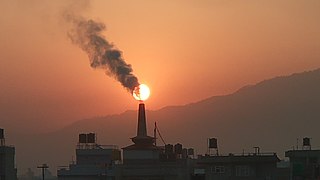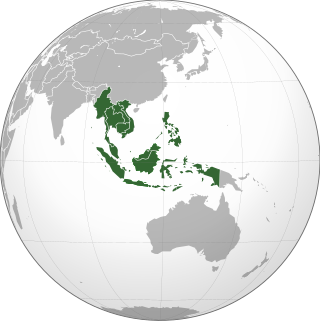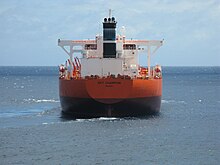
The Exxon Valdez oil spill was a major environmental disaster that occurred in Alaska's Prince William Sound on March 24, 1989. The spill occurred when Exxon Valdez, an oil supertanker owned by Exxon Shipping Company, bound for Long Beach, California, struck Prince William Sound's Bligh Reef, 6 mi (9.7 km) west of Tatitlek, Alaska at 12:04 a.m. The tanker spilled more than 10 million US gallons (240,000 bbl) of crude oil over the next few days.

The International Maritime Organization is a specialised agency of the United Nations responsible for regulating maritime transport. The IMO was established following agreement at a UN conference held in Geneva in 1948 and the IMO came into existence ten years later, meeting for the first time on 17 March 1958. Headquartered in London, United Kingdom, the IMO, in 2024, has 176 Member States and three Associate Members.

An oil spill is the release of a liquid petroleum hydrocarbon into the environment, especially the marine ecosystem, due to human activity, and is a form of pollution. The term is usually given to marine oil spills, where oil is released into the ocean or coastal waters, but spills may also occur on land. Oil spills can result from the release of crude oil from tankers, offshore platforms, drilling rigs, and wells. They may also involve spills of refined petroleum products, such as gasoline and diesel fuel, as well as their by-products. Additionally, heavier fuels used by large ships, such as bunker fuel, or spills of any oily refuse or waste oil, contribute to such incidents. These spills can have severe environmental and economic consequences.

Exxon Valdez was an oil tanker that gained notoriety after running aground in Prince William Sound, spilling her cargo of crude oil into the sea. On 24 March 1989, while owned by the former Exxon Shipping Company, captained by Joseph Hazelwood and First Mate James Kunkel, and bound for Long Beach, California, the vessel ran aground on the Bligh Reef, resulting in the second largest oil spill in United States history. The size of the spill is estimated to have been 40,900 to 120,000 m3. In 1989, the Exxon Valdez oil spill was listed as the 54th-largest spill in history.

The International Convention for the Prevention of Pollution from Ships, 1973 as modified by the Protocol of 1978, or "MARPOL 73/78" is one of the most important international marine environmental conventions. It was developed by the International Maritime Organization with an objective to minimize pollution of the oceans and seas, including dumping, oil and air pollution.

The Oil Pollution Act of 1990 (OPA) was passed by the 101st United States Congress and signed by President George H. W. Bush. It works to avoid oil spills from vessels and facilities by enforcing removal of spilled oil and assigning liability for the cost of cleanup and damage; requires specific operating procedures; defines responsible parties and financial liability; implements processes for measuring damages; specifies damages for which violators are liable; and establishes a fund for damages, cleanup, and removal costs. This statute has resulted in instrumental changes in the oil production, transportation, and distribution industries.
A double hull is a ship hull design and construction method where the bottom and sides of the ship have two complete layers of watertight hull surface: one outer layer forming the normal hull of the ship, and a second inner hull which is some distance inboard, typically by a few feet, which forms a redundant barrier to seawater in case the outer hull is damaged and leaks.
The MV Sea Empress was a single-hull Suezmax oil tanker that ran aground at the entrance to the Milford Haven harbour on the southwest coast of Wales in February 1996. The ensuing oil spill, Britain's third largest oil spillage and the 12th largest in the world at the time, devastated a considerable area of local coastline and killed many birds, and continued to affect the Pembrokeshire coast for years afterwards.

The Prestige oil spill occurred off the coast of Galicia, Spain in November 2002, caused by the sinking of the 26-year-old, structurally deficient oil tanker MV Prestige, carrying 77,000 tonnes of heavy fuel oil. During a storm, it burst a tank on 13 November, and French, Spanish, and Portuguese governments refused to allow the ship to dock. The vessel subsequently sank on 19 November, about 210 kilometres (130 mi) from the coast of Galicia. It is estimated that it spilled 60,000 tonnes or a volume of 67,000 m3 (17.8 million US gal) of heavy fuel oil.

Ship grounding or ship stranding is the impact of a ship on seabed or waterway side. It may be intentional, as in beaching to land crew or cargo, and careening, for maintenance or repair, or unintentional, as in a marine accident. In accidental cases, it is commonly referred to as "running aground".

An oil tanker, also known as a petroleum tanker, is a ship designed for the bulk transport of oil or its products. There are two basic types of oil tankers: crude tankers and product tankers. Crude tankers move large quantities of unrefined crude oil from its point of extraction to refineries. Product tankers, generally much smaller, are designed to move refined products from refineries to points near consuming markets.

The Coulombi egg tanker is a design that is aimed at reducing oil spills. It was approved by the International Maritime Organization (IMO) as an alternative to the double hull concept. The United States Coast Guard does not allow this design to enter US waters, effectively preventing it from being built.
Oil tankers generally have from 8 to 12 tanks. Each tank is split into two or three independent compartments by fore-and-aft bulkheads. The tanks are numbered with tank one being the forwardmost. Individual compartments are referred to by the tank number and the athwartships position, such as "one port", "three starboard", or "six center."

The environmental impact of shipping include air pollution, water pollution, acoustic, and oil pollution. Ships are responsible for more than 18% of nitrogen oxides pollution, and 3% of greenhouse gas emissions.
All cargo vessels where MARPOL Convention is applicable must have an oil record book in which the officer responsible will record all oil or sludge transfers and discharges within the vessel. This is necessary for authorities to be able to monitor if a vessel's crew has properly disposed of their oil discharges at sea.
Oil spill governance in the United States is governed by federal law.
The Prince William Sound Regional Citizens' Advisory Council is an independent non-profit organization based in Anchorage and Valdez, Alaska, whose mission is to promote the environmentally-safe operation of the Alyeska Pipeline's Valdez Marine Terminal and associated oil tankers, and to inform the public of those activities.
Marpol Annex I is the first implementation made by Marpol 73/78, one of the most important international marine environmental conventions. The convention was designed to minimize pollution of the seas from ships. The objective of the convention is to preserve the marine environment through the complete elimination of pollution by oil and other harmful substances and the minimization of accidental discharge of such substances. The Marpol Annex I began to be enforced on October 2, 1983, and it details the prevention of pollution by oil and oily water.
The International Convention for the Prevention of Pollution of the Sea by Oil (OILPOL) was an International Treaty signed in London on 12 May 1954. It was updated in 1962, 1969, and 1971. OILPOL was subsumed by the International Convention for the Prevention of Pollution from Ships (MARPOL) in 1973.

Southeast Asia is home to a diverse marine environment. The region is host to extensive coral reefs, mangroves and seagrass beds, and has even been described as the Amazon rainforest of the ocean. The region is estimated to contain approximately 35% of the world’s mangrove species and over 45% of the world’s seagrass species. The shipping industry has multiple damaging impacts on marine habitats and wildlife, such as pollution from port actives, oil spills ballast and bilge discharge, waste dumping from ships and direct physical impact from grounding and anchor damage.














